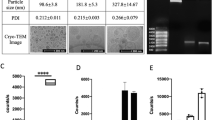Abstract
The gene expression plasmid, pET-Lmluc, for the fusion protein of the hyaluronan binding domain from human TSG-6 [product of tumor necrosis factor (TNF)-stimulated gene-6] and luciferase from Renilla reniformis was constructed. The fused gene was expressed in Escherichia coli and the resulted insoluble Lm-luc fusion protein was purified and refolded to recover both the hyaluronan binding capability and the luciferase activity. Hyaluronan as low as 1 ng ml−1 was detected by using the indirect enzymatic immunological assay with the refolded Lm-luc fusion protein.
Similar content being viewed by others
References
Carrio MM, Cubarsi R, Villaverde A (2000) Fine architecture of bacterial inclusion bodies. FEBS Lett. 471: 7–11.
Christner JE, Brown ML, Dziewiatkowski DD (1978) Affinity binding of the cartilage proteoglycan protein-keratan sulfate core to immobilized hyaluronic acid. Anal. Biochem. 90: 22–32.
Dahl IMS, Turesson I, Holmberg E, Lilja K (1999) Serum hyaluronan in patients with multiple myeloma: correlation with survival and Ig concentration. Blood 93: 4144–4148.
Day AJ, Aplin RT, Willis AC (1996) Overexpression, purification, and refolding of link module from human TSG-6 in Escherichia coli: effect of temperature, media, and mutagenesis on lysine misincorporation at arginine AGA codons. Protein Expres. Purif. 8: 1–16.
Delpech B, Bertrand P, Maingonnat C (1985) Immunoenzymoassay of the hyaluronic acid-hyaluronectin interaction: application to the detection of hyaluronic acid in serum of normal subjects and cancer patients. Anal. Biochem. 149: 555–565.
Delpech B, Bertrand P, Maingonnat C, Girard N, Chauzy C (1995) Enzyme-linked hyaluronectin: a unique reagent for hyaluronan assay and tissue location and for hyaluronidase activity detection. Anal. Biochem. 229: 35–41.
Gillet D, Ezan E, Ducancel F, Gaillard C, Ardouin T, Istin M, Menz A, Boulain JC, Grognet JM (1993) Enzyme immunoassay using a rat prolactin-alkaline phosphatase recombinant tracer. Anal. Chem. 65: 1779–1784.
Kahmann JD, Koruth R, Day AJ (1997) Method for quantitative refolding of the link module from human TSG-6. Protein Expres. Purif. 9: 315–318.
Kohda D, Morton CJ, Parkar AA, Hatanaka H, Inagaki FM, Campbell ID, Day AJ (1996) Solution structure of the link module: a hyaluronan-binding domain involved in extracellular matrix stability and cell migration. Cell 86: 767–775.
Maeda Y, Ueda H, Kazami J, Kawano G, Suzuki E, Nagamune T (1997) Engineering of functional chimeric protein G-Vargula luciferase. Anal. Biochem. 249: 147–152.
Neame PJ, Barry FP (1993) The link proteins. Experientia 49: 393–402.
Sherman L, Sleeman J, Herrlich P, Ponta H (1994) Hyaluaronate receptors: key players in growth, differentiation, migration and tumor progression. Curr. Opin. Cell Biol. 6: 726–733.
Zhang XM, Kobatake E, Kobayashi K, Yanagida Y, Aizawa M (2000) Genetically fused protein A-luciferase for immunological blotting analyses. Anal. Biochem. 282: 65–69.
Author information
Authors and Affiliations
Corresponding author
Rights and permissions
About this article
Cite this article
Chang, TS., Wan, HM., Chen, CC. et al. Fusion protein of the hyaluronan binding domain from human TSG-6 with luciferase for assay of hyaluronan. Biotechnology Letters 25, 1037–1040 (2003). https://doi.org/10.1023/A:1024178110310
Issue Date:
DOI: https://doi.org/10.1023/A:1024178110310




